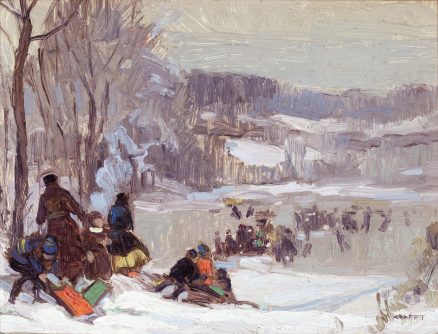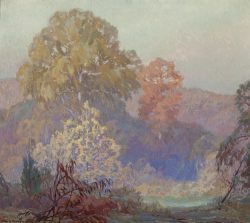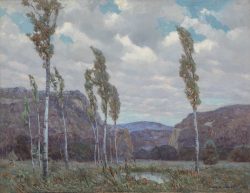Untitled (Study for At Forest Spring)
, circa 1920sOil on board, 6 by 8 inches
- Categories
- Landscapes
- Zoom in on Artwork
- Print Page
- Email Page to Friend
Probably made on site, Carl Krafft’s diminutive study captures a winter vista of snow-covered ground sloping toward a skating pond fringed with trees. The composition features the distinct diagonal recession often seen in Krafft’s mature landscape work: here, the eye is drawn from the cluster of four nearby figures at the lower left to the sledders to their right and beyond them toward distant bands of skaters on the pond. Touches of bright red, blue, and green in the figures’ winter garb highlight a palette otherwise confined to white and varying shades of dull brown. Krafft applied quick strokes of paint on a smooth panel surface; the white ground is clearly visible through the brush marks, particularly in the thinly painted background. Viewed close-up the painting is almost abstract in its reductive presentation of figures, sleds, trees, and other features of the scene.
This sketch is said to be a study for At Forest Spring, but no work of this title has been attributed to Krafft and no locale of that name is known. The artist may have made the sketch without translating it directly into a larger work. It is closely related to two undated sledding scenes that likely depict settings in Palos Hills, southwest of Chicago, where the artist painted year-round as early as 1921. In the mid-1920s and early 1930s he used somewhat gestural brushwork that lends his landscapes a graphic energy. Krafft’s wintertime scenes “have carved for themselves a niche in our memories from which they cannot be dislodged,” in the view of Chicago Tribune critic Eleanor Jewett.i Snow scenes dominated his 1932 solo exhibition at the H. Lieber Company galleries in Indianapolis. The show included two small canvases noted by a local reviewer for their “subtle beauty of color tone and a certain charm of handling which are lacking in most of the larger canvases,”ii a description that could apply to this sketch as well. Exemplifying Krafft’s joyful response to winter, it demonstrates his confident command of both composition and brushwork.
Bundled up against the cold in functional winter-weather gear, the figures in Krafft’s sledding pictures are representative of the working-class residents of the industrial towns along the Sanitary and Ship Canal linking Chicago with the Mississippi River. The artist turned his attention to such prosaic subjects and scenes around 1920, when he began painting along the Mississippi River near Galena, Illinois. His sledding images focus on recreation rather than work, however, and may have been inspired in part by George Bellows’s acclaimed skating scene Love of Winter (1914), acquired in 1914 for the Art Institute of Chicago by the patrons’ group Friends of American Art.
Wendy Greenhouse, PhD
Donated by M. Christine Schwartz to the Oak Park River Forest History Museum, Oak Park, Illinois, in 2021
i Eleanor Jewett, “Portraits of Winter among the Pictures at Chicago Galleries,” Chicago Tribune, Jan. 31, 1929.
ii Lucille E. Morehouse, “Carl Krafft Oils at Lieber’s Form Fine Landscape Display,” Indianapolis Star, Sept. 25, 1932.


